THANK YOU!
YOUR PURCHASE OF THESE BOOKS SUPPORTS THE WEB SITES THAT BRING TO YOU THE HISTORY BEHIND OLD AIRFIELD REGISTERS
Your copy of the Davis-Monthan Airfield Register 1925-1936 with all the pilots' signatures and helpful cross-references to pilots and their aircraft is available at the link. 375 pages with black & white photographs and extensive tables
---o0o---
The Congress of Ghosts (available as eBook) is an anniversary celebration for 2010. It is an historical biography, that celebrates the 5th year online of www.dmairfield.org and the 10th year of effort on the project dedicated to analyze and exhibit the history embodied in the Register of the Davis-Monthan Airfield, Tucson, AZ. This book includes over thirty people, aircraft and events that swirled through Tucson between 1925 and 1936. It includes across 277 pages previously unpublished photographs and texts, and facsimiles of personal letters, diaries and military orders. Order your copy at the link.
---o0o---
Military Aircraft of the Davis Monthan Register 1925-1936 is available at the link. This book describes and illustrates with black & white photographs the majority of military aircraft that landed at the Davis-Monthan Airfield between 1925 and 1936. The book includes biographies of some of the pilots who flew the aircraft to Tucson as well as extensive listings of all the pilots and airplanes. Use this FORM to order a copy signed by the author, while supplies last.
---o0o---
Art Goebel's Own Story by Art Goebel (edited by G.W. Hyatt) is written in language that expands for us his life as a Golden Age aviation entrepreneur, who used his aviation exploits to build a business around his passion. Available as a free download at the link.
---o0o---
Winners' Viewpoints: The Great 1927 Trans-Pacific Dole Race (available as eBook) is available at the link. This book describes and illustrates with black & white photographs the majority of military aircraft that landed at the Davis-Monthan Airfield between 1925 and 1936. The book includes biographies of some of the pilots who flew the aircraft to Tucson as well as extensive listings of all the pilots and airplanes. Use this FORM to order a copy signed by the author, while supplies last.
---o0o---
Clover Field: The first Century of Aviation in the Golden State (available in paperback) With the 100th anniversary in 2017 of the use of Clover Field as a place to land aircraft in Santa Monica, this book celebrates that use by exploring some of the people and aircraft that made the airport great. 281 pages, black & white photographs.
---o0o---
YOU CAN HELP
I'm looking for information and photographs of this airplane to include on this page. If you have some you'd like to share, please click this FORM to contact me.
---o0o---
Thanks to Guest Editor Bob Woodling for help researching this page.
---o0o---
SPONSORED LINKS
HELP KEEP THESE WEB SITES ONLINE
FOR YOUR CONVENIENCE
You may NOW donate via PAYPAL by clicking the "Donate" icon below and using your credit card. You may use your card or your PAYPAL account. You are not required to have a PAYPAL account to donate.
When your donation clears the PAYPAL system, a certified receipt from Delta Mike Airfield, Inc. will be emailed to you for your tax purposes.
---o0o---
DENIS J. MULLIGAN
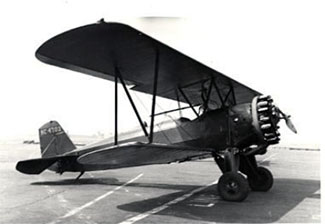 |
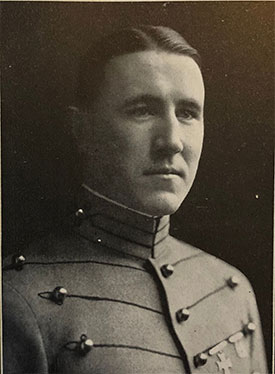 |
Denis Mulligan, left, landed once at Pitcairn Field, on Friday, June 26, 1931. He carried two passengers he identified as his wife and Wesley Morck. They flew in the Stearman C-2B (S/N 116) Mulligan identified as NC4703, right. NC4703 is no longer registered,although the number has been reserved. Does anyone KNOW if NC4703 is under restoration?
Based at Miller Field, Staten Island, NY, Mulligan wrote "Staten Island" in the remarks column of the Register. According to his obituary, below, he was operations officer for the army's 102nd Observation Squadron at Miller Field.
The Rocky Mountain Online Archive (exhibiting information about archival collections in Colorado, New Mexico and Wyoming) holds a collection of Mulligan's papers and memorabilia from 1918-1985. The collection consists of seven boxes of material held at the University of Wyoming American Heritage Center (UWAHC). The UWAHC description reads:
| "The Denis J. Mulligan collection contains professional and personal correspondence and manuscripts, reports, newspaper clippings, photographs, negatives, and maps. The materials pertain to various aspects of Mulligan's career, including work at the Bureau of Air Commerce, Civil Aeronautics Board, and the President's Air Policy Commission. Also included are articles written by Mulligan and his statements before Congress. Personal items from his days at the United States Military Academy such as photographs and negatives, ephemera, and correspondence are present as well." |
This material was received from Mrs. Elizabeth Mulligan in August of 1986 (see below).There is one other known archival collection created by Denis J. Mulligan at the U.S. Military Academy Library, Special Collections.
The collection holds four of his pilot log books. I asked the Archive to scan a couple of pages around the time of his visit to Willow Grove. They sent me the following page enumerating flights for June 1931. There is no indication of a civilian flight in the Stearman Mulligan identified in the Register. Rather, on the 26th he flew a Douglas O-38, an observation airplane used by the Air Corps between 1931 and 1934. He might have kept separate books for military and civilian flights.
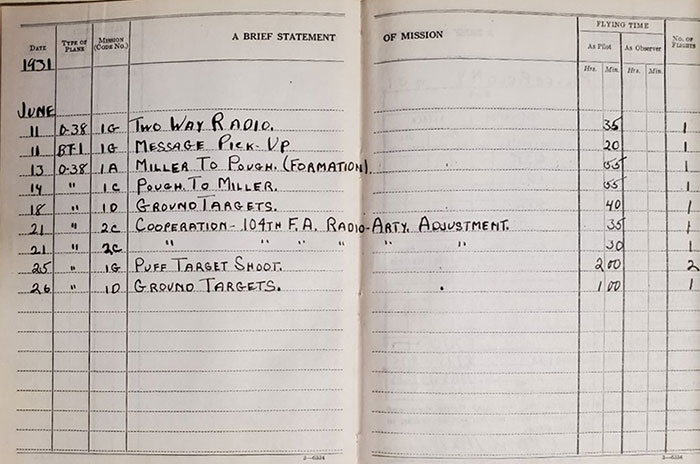 |
Of interest is this second page summarizing his total time to-date for June 1931. He had flown as pilot for 7.5 (military) hours during the month of June. He logged 2 hours 15 minutes as observer. Thanks to the UWAHC for sharing these images with us.
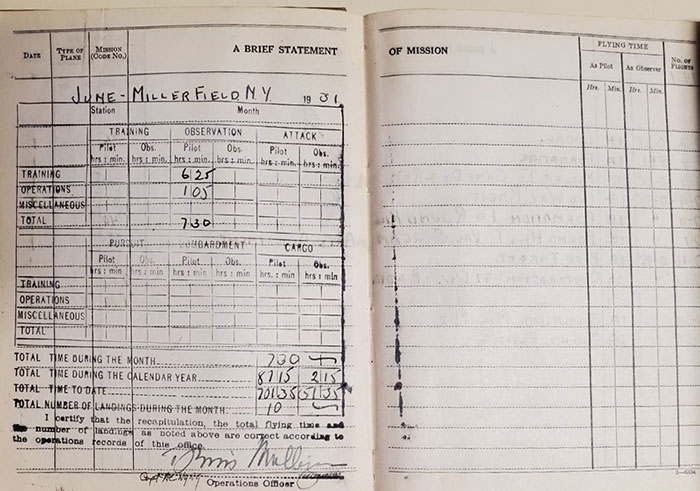 |
Continuing, Guest Editor Bob Woodling (right sidebar) postulates about the Willow Grove Register record, "Apparently Mulligan and Morck were active in New York Society and were reported as being ushers together at a NY wedding [reported in the Washington, D.C Evening Star, October 2, 1926]. Morck was from Oil City, PA, so perhaps the two were flying to, or from, there and stopped at Pitcairn on the way?" Interestingly, passenger Morck was a graduate of Princeton University, class of 1925. When he died, a decade after Mulligan, the Princeton Alumni Weekly published an obituary, as follows.
WES MORCK DIED at his home in Williamsburg, VA., June 18, 1994. He was 93. He and his wife, Virginia "Diddy" Beathard had recently celebrated their 53rd anniversary. Wes was born in Oil City, PA, and prepared at The Hill School, where he first exhibited his proficiency in tennis, golf, and baseball. At Princeton, he was a member of Ivy. After college, Wes joined the great rush of collegians to Wall Street. Jobs were scarce, bur he joined the firm of Brinton & Co, and acquired a sizeable interest in the Clinton Oil Co. and a seat on the New York Stock Exchange. With the outbreak of WWII, Wes offered his services to the Office of Strategic Services for the duration and did Red Cross and community-service work. With the war's end, he resumed his active business and social life, holding memberships in the Downtown Athletic Club, the Huntingdon Yacht Club, and the Knickerbocker Club, with occasional overseas trips with his growing family. Wes had a delightful sense of humor and was always cheery; he was often the life of the party, as his friends can attest. In addition to his widow, he leaves two daughters and a son, plus several grandchildren. The class extends sympathy to his family. |
I know little about Mulligan's early life or schooling. He was born August 12, 1900 in Riverdale, NY. He was registered for the draft at age 18 on September 12, 1918. He was still in high school.
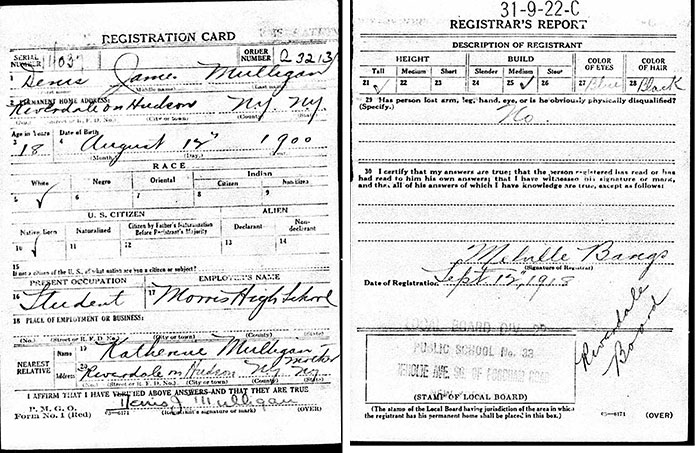 |
 |
He attended Columbia College and then West Point, from which he graduated in 1924. He joined the Air Corps in 1925, retiring from active duty in 1926, right, when he was commissioned in the Officers' Reserve Corps. According to a military record I examined, he had an Observer rating as of 1925. He later earned command pilot wings, and he wears theM in the undated photograph below, from a card containing a summary of his military service through 1934.
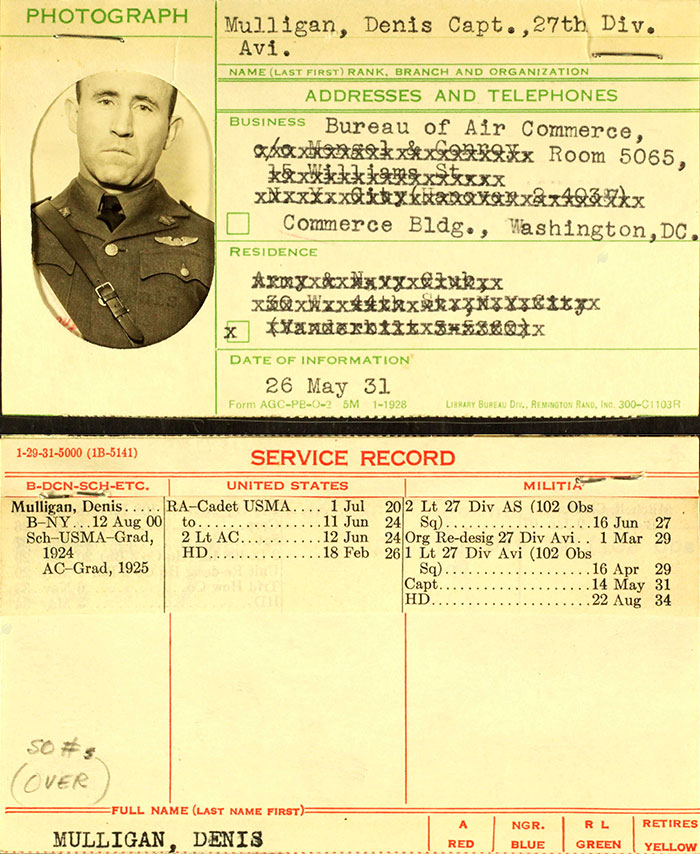 |
Interestingly, it appears Mulligan explored another opportunity during his 1925-26 hiatus from the army. If this was because he was 25 years old and needed to get away, or if it was a dislike for military life, or a relationship gone sour, one can only guess. But he chose to have a go at life on the sea. The form below is identified as a Seaman's Protection Certificate, which was used by mariners to prove their citizenship when in foreign ports. This one was carried by Mulligan aboard his assigned ship, the Storm King on which he was to be employed as an oiler during the summer of 1926.
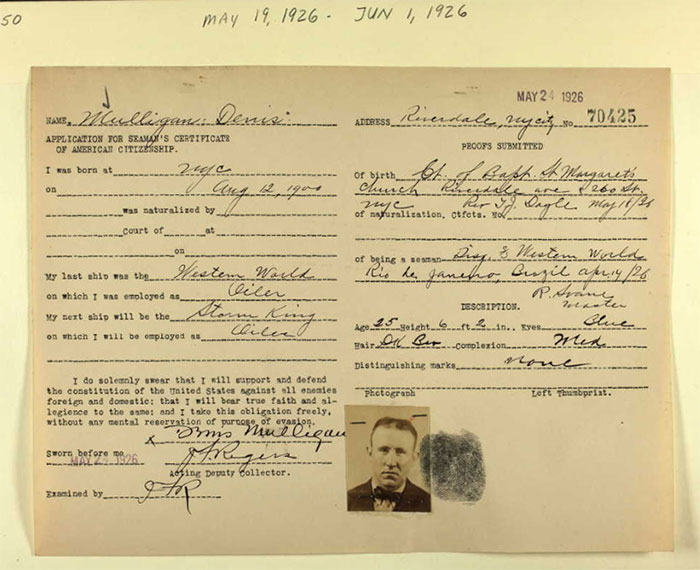 |
The S.S. Storm King was a cargo ship of ill fate. About three weeks after the date of his protection certificate, Storm King ran aground at Cape Serrat, Tunisia, June 15, 1926 (or at Cape Negre, Tunisia, June 13, 1926, depending upon source). Mulligan survived the grounding and was repatriated to the U.S. sailing aboard the S.S. Canada 70 from Marseilles on August 7th, and arriving in Providence, RI on August 23rd. The immigration form documenting his return is below. Annotated in the upper right corner is, "MEN OF WRECKED AMERICAN STEAMER 'STORM KING' REPATRIATED TO THE UNITED STATES."
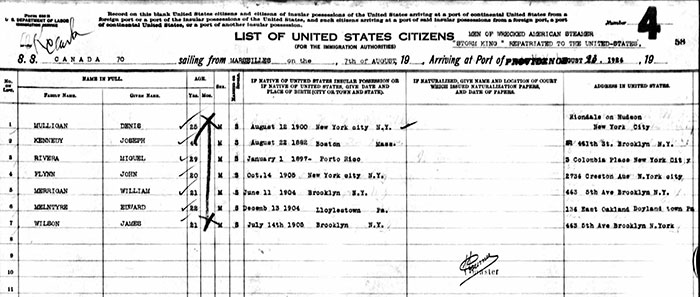 |
You could postulate that Mulligan had had his fill of the mariner's life, because a few years later he graduated from Fordham University's law school. The announcement he graduated appeared in The New York Times (NYT), June 10, 1930, below. Notification he passed the New York State Bar Exam was published in The NYT, January 5, 1931. He landed at Willow Grove six-months later.
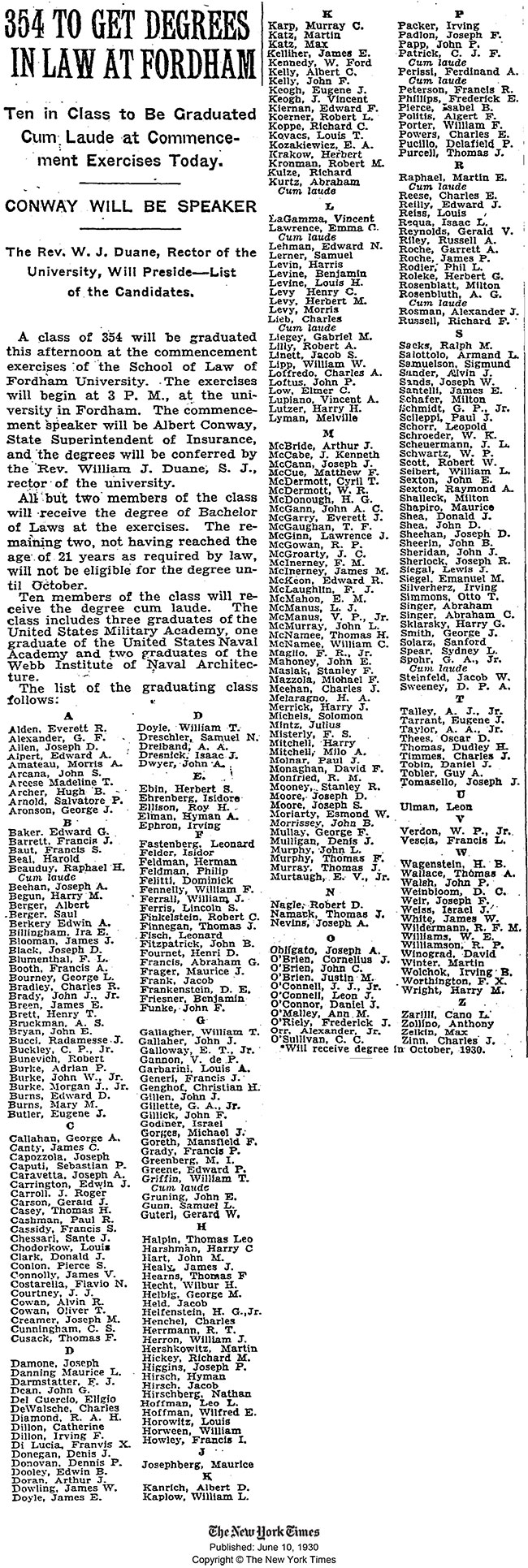 |
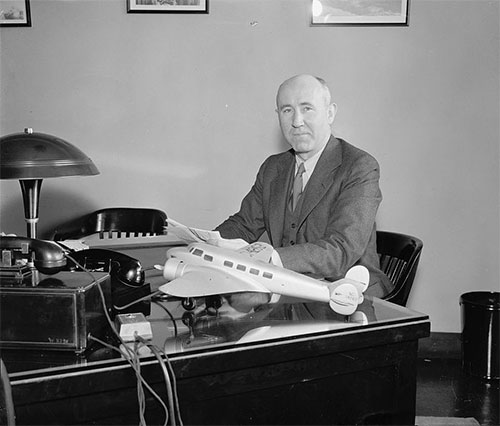 |
I do not know when he started practicing law, but Mulligan became the Chief of the Regulation & Enforcement Section of the Bureau of Air Commerce of the Department of Commerce in 1934, just three years after passing the bar exam. His photograph, left, shows him at work. The furniture suggests a government office.
The model airplane on his desk is of a Lockheed Model 10, registration number NC14262. We can date the photograph to after 1936 when 14262 was manufactured. It probably had a role in the military during WWII. We might also date the photo to the late 1940s, because NC14262 found its way to Wisconsin Central Airlines in 1948, below.
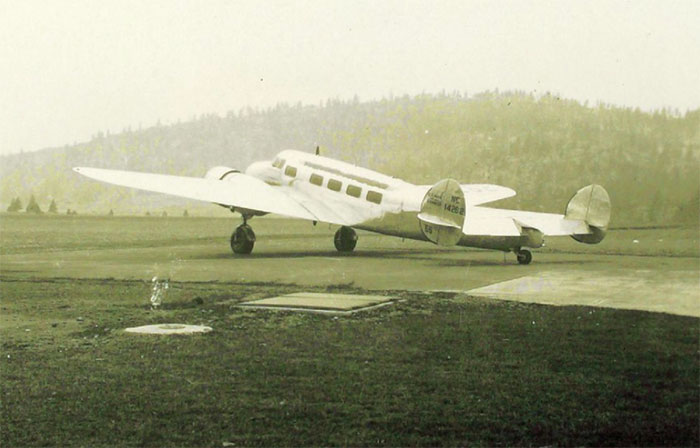 |
But, I digress. The New York Times, September 9, 1936 recorded Mulligan among the passengers on the S.S. Manhattan to Europe. I do not know if he was representing the U.S. on international official business. He was not with his wife. I do not know when they became separated, but he was coded as single at the time of the 1940 Census (see below).
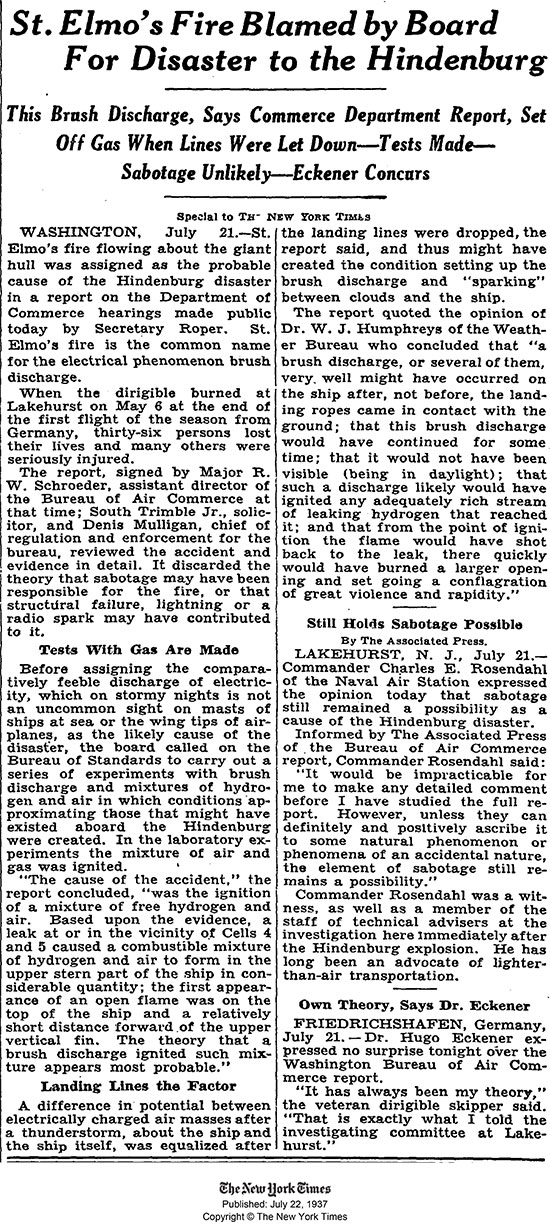 |
But, he had an interesting job later in the 1930s. For example, as the chief of his Section, Mulligan was on the team that investigated the fire and crash of the dirigible Hindenburg on May 5, 1937. The final decision on the cause of the fire was published in The New York Times, July 22, 1937, right.
That year was a busy one, too, for Mulligan's Section. On August 11, 1937 the crash of an Eastern Airlines DC-3 in Florida resulted in his assignment to head the investigation. I did not include the continuation of this article, which showed a grisly photograph of the wrecked airplane. This was an historic crash for Eastern, as it was their first. It was reported in The New York Times, August 11, 1937, below.
 |
He traveled again by sea during 1937. The Washington, D.C Evening Star,August 31, 1937 detailed his voyage on the aircraft carrier U.S.S. Ranger to Lima, Peru to participate in the Inter-American Technical Aviation Conference on September 16th. And an immigration document showed he sailed by himself from the Panama Canal Zone on October 5th aboard the S.S. Pennsylvania, arriving in New York on October 11th. His address in the U.S. was given as "Bureau of Commerce, Washington, D.C." One other passenger was identified as a government bureaucrat (Department of Education). It appeared this voyage was part of his homeward travel after the Lima conference.
In 1938, as head of the Department of Aeronautics, he greeted Douglas "Wrong Way" Corrigan to Washington, DC and was responsible for the wrist slap Corrigan received for making his "wrong way" flight to California, which wound up to be the opposite direction to Ireland. Mulligan and Corrigan were captured in the same photograph, below, from The New York Times, August 11, 1938.
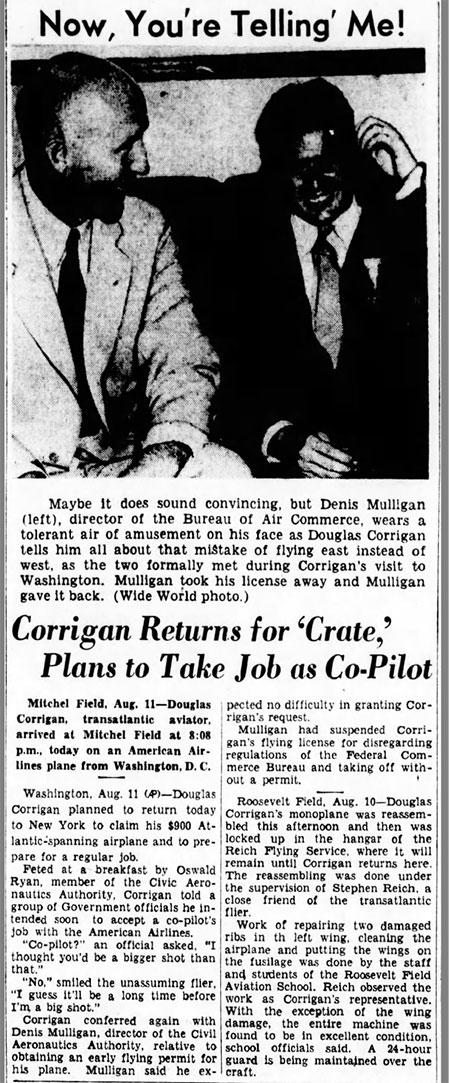 |
That's not to say that Corrigan was not castigated for his "error." His pilot certificate was suspended before he returned to the United States, as reported in The NYT of July 20, 1938, below.
 |
 |
Separately, The Times of August 11th, right, reported a tongue-in-cheek conversation between Corrigan and Mulligan and alluded to the impending return of his pilot certificate.
Further, Mulligan became an executive in the newly formed Civil Aeronautics Authority, as reported in The New York Times, August 23, 1938, below. The link provides a treatise on the Civil Aeronautics Act of 1938 from the Journal of Air Law and Commerce, 9:1, pages 451-459. He wasn't the only Register pilot who participated in the development of early aviation regulatory infrastructure. See Clover Field pilot Hiram Bingham.
 |
Among his official social duties, The Washington, D.C Evening Star, July 22, 1938 reported Mulligan's attendance at a dinner celebrating the round-the-world flight by Clover Field Register pilot Howard Hughes and his crew, below. Note mention in the article of additional Register pilots H.H. Arnold and Frank Andrews.
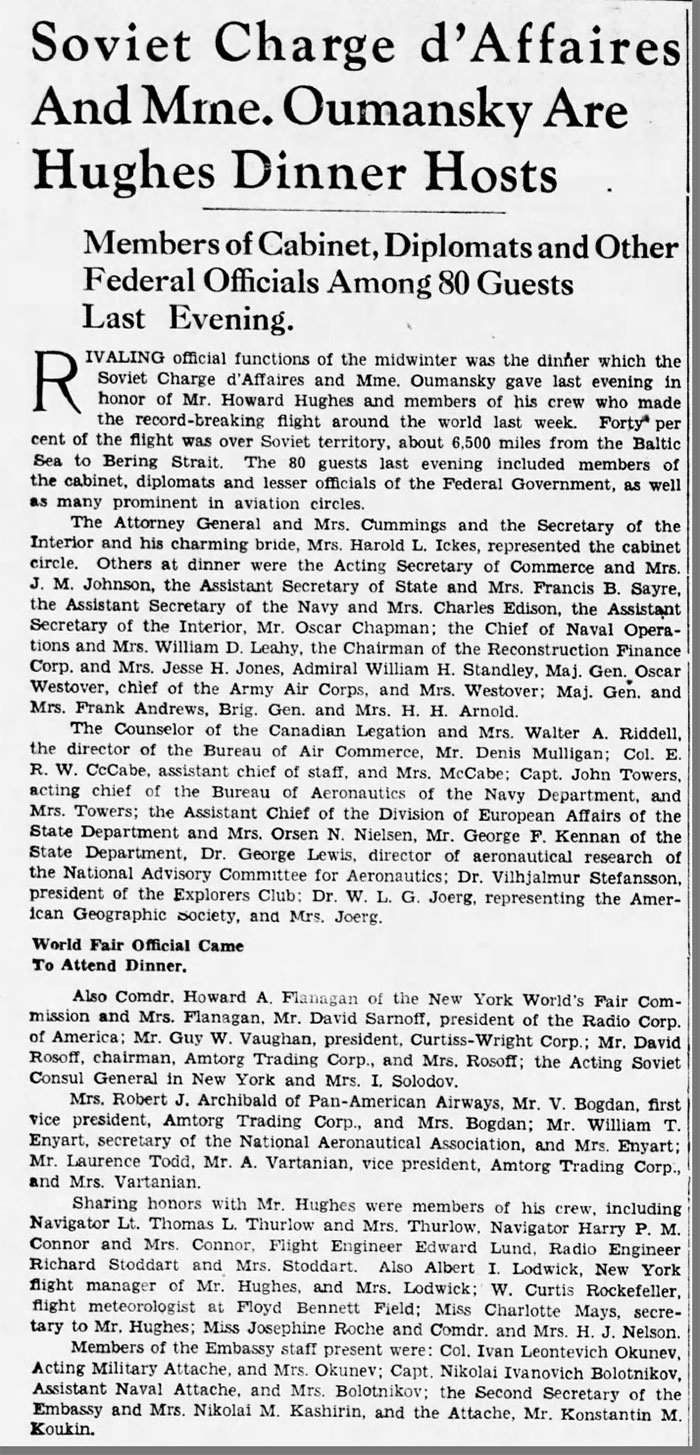 |
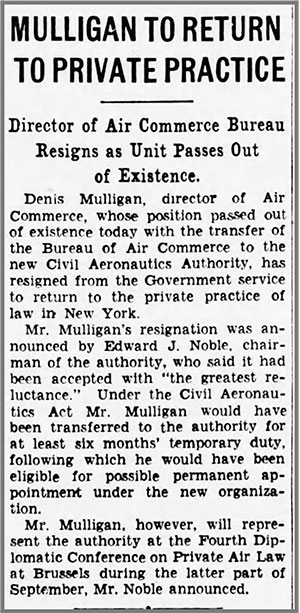 |
Scarcely a month after the Hughes dinner, Mulligan resigned from the government. The reason was because the organization of the Civil Aeronautics Authority had eliminated his position, as documented in The Washington, D.C Evening Star, August 23, 1938, left. Compare this information to the NYT article of the same date, above, which suggested Mulligan was continuing with the new organization. The two articles agree in his intention to represent the Authority at a conference in Brussels that September.
Further, The Washington, D.C Evening Star, November 29, 1938, below, reported his attendance at the Brussels conference, as well as a post-conference survey of European civil aviation.
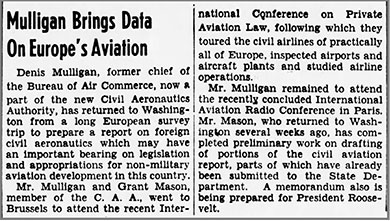 |
The U.S. Census for 1940 coded Mulligan as living a stone's throw from Dupont Circle at 1344 Connecticut Avenue, Washington, D.C. in a $100 per month apartment. The apartment building is still there. He was single and working as a lawyer ("Private Practice, Air Law"). According to the Census, he had lived there at least since 1935 and was putting in 50-hour work weeks.
Mulligan returned to active duty with the Army Air Force in 1941. The New York Times, September 24, 1941, below, documented his assignment by president Roosevelt to a Pan-American Air Board to oversee the standardization of aeronautical law and technology in the Western Hemisphere. Note the reference to the Lima conference he attended in 1937. Note also that Air Board member John Jouett was a fellow Register pilot.
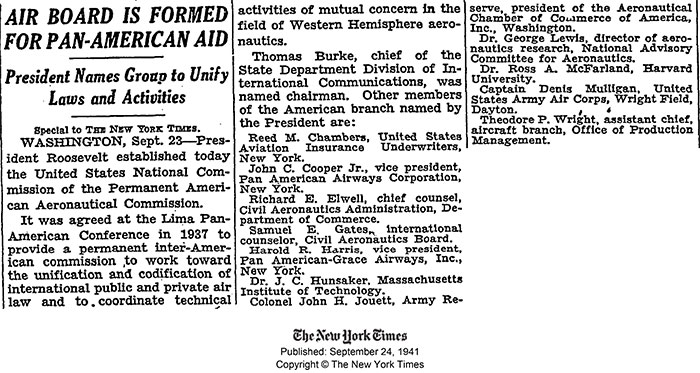 |
After 1945 he returned to being a lawyer. In 1946 he was awarded the Legion of Merit as in the following notation from the link. The award was announced in The News, Patterson, NJ, July 25,1946.
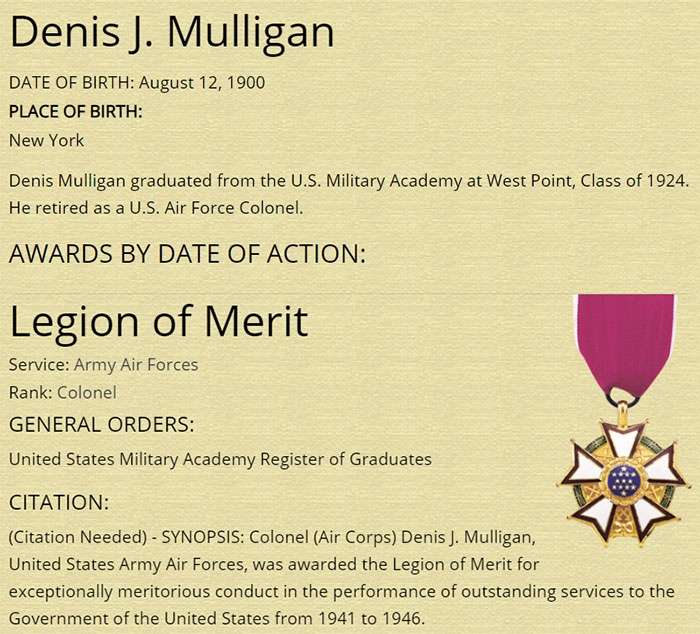 |
He was restored to active duty in the Korean conflict, where he served as executive officer to the director of the Directorate of Production and Procurement.
Mulligan flew West December 21, 1983 from Montclair, NJ. He was 83 years old. His obituary is below from The Montclair Times, December 29, 1983. The article mentions his year as a sailor, and his assignment to Miller Field, his stated destination when he departed from Willow Grove. It also refers to his wife, Elizabeth, and his three children. I do not know which of his wives was the children's mother.
"A memorial mass for Colonel Denis J. Mulligan, United States Air Force-retired, was held Monday at St. Cassian's Church. Burial will be at West Point, N. Y. with full military honors. Mr. Mulligan died on Dec. 21. He opened an office in Montclair in 1954 as an industrial consultant until 1972 when he retired. He moved to Montclair in 1952.
"He received his bachelor of law from Fordham University Law School in 1930 and a doctor of science of law from Brooklyn Law School of St. Lawrence University in 1934, and was admitted to the Bar in New York -State in 1931. He practiced law in New York City and Washington D.C. where he was admitted to practice before the Supreme Court. Mr. Mulligan served as investigator and wrote the final report on the Hindenburg disaster in 1937. He made a survey of the European airlines for the Civil Aeronautics Board and advised the Irish republic on the building of Dublin Airport. He returned to active duty with the Army Air Corps in 1941 until the end of World War II when he resigned to practice law in New York City He was recalled to active duty during the Korean War and, upon returning from the Air Force in 1952 moved with his family to Montclair. From 1952-54 he was connected to the Wright-Aeronautical division of Curtiss-Wright Corp. He had published articles in the Journal of Air Law, Federal Bar Association Journal, Congressional Record and the U.S. Air Services Magazine. He was a member of the Air Force Association, Order of Daedalians, Army Athletes Association, Associates of Graduates USMA, American Legion Aviator's Post 743, American Institute of Aeronautics and Astronautics, Dunworkin' Club of Montclair, former member of the Montclair Society of Engineers, New York State Bar Association. He held honorary degree of doctor of law from University of San Marco, Peru. Surviving are his wife, Elizabeth, and three children, Mona, Terence and Susanne." |
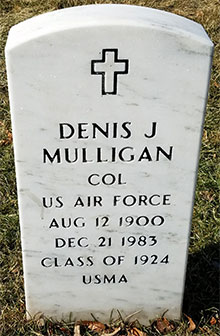 |
His wife joined him in April 2000.
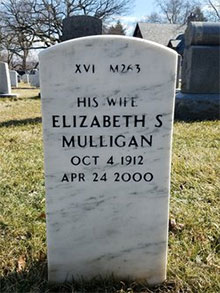 |
---o0o---
SPONSORED LINKS
THIS PAGE UPLOADED: 08/28/20 REVISED: 10/16/20
